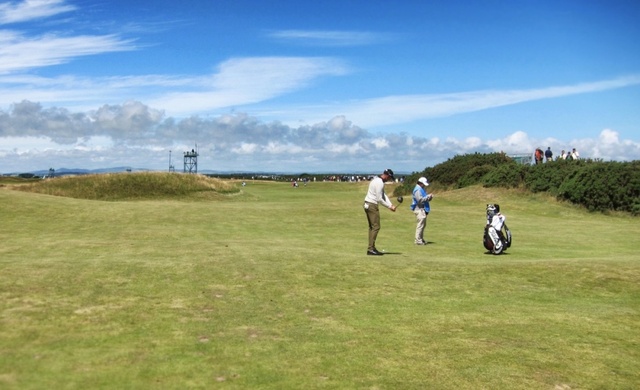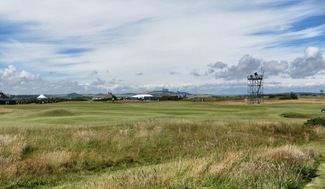When you come to think of it that is the secret of most of the great holes all over the world. They all have some kind of a twist. C.B. MACDONALD
R&A Will Not Be Adding A Walker Cup Mid-Am Quota
/Nick Rodger reports that the Great Britain and Ireland Team will not be joining the USGA's American team in requiring two mid-amateurs play in the Walker Cup. Mostly, the mid-am is a distinctly American obsession.
Nathan Smith, the current holder of that particular crown, has played in the past two Walker Cups while the last time Team USA had two mid-amateur men in the line-up was at Ganton in 2003, where Trip Kuehne and George Zahringer flew the flag.
In the UK, the British Mid-Amateur Championship, run under the auspices of the Royal & Ancient since 1995, was discontinued in 2007 while the Scottish equivalent withered on the vine and eventually dropped off the domestic schedule a couple of seasons ago. Given the mid-am culture here, it's hardly a revelation to discover that the R&A don't have any plans to follow the USGA's somewhat bold Walker Cup lead.
"Bifurcation is the imperfect answer we're looking for, and 2013 might be the year we decide."
/Ernie Paying A Compliment: "The R&A want to have the same kind of scores winning today as you did back in the 1920s."
/Martin Dempster talks to Ernie Els and Louis Oosthuizen about R&A Chief Inspector Architect Dawson's changes to the Old Course.
 Louis, the last man to win the Open at St. Andrews, not surprisingly had no idea what Dempster was asking about. Els, the 2012 Open Champion, tried to defend the changes but in doing so unknowingly offered the worst indictment possible.
Louis, the last man to win the Open at St. Andrews, not surprisingly had no idea what Dempster was asking about. Els, the 2012 Open Champion, tried to defend the changes but in doing so unknowingly offered the worst indictment possible.
“Most of the courses we’ve played in the past ten or so years have changed, including Troon, Royal Liverpool and Sandwich. In fact, they’re making changes to all of the courses on the rota in a bid to make the challenge as tough as possible.”
A course designer himself, Els added: “The only thing that bothers me a bit about it is that, when the wind changes direction sometimes on these courses, it can be tough to get to the fairway from some of these new tees.
Quibble, quibble! These pros today are so spoiled. Go on...
“But I think these courses do need to change. The R&A want to have the same kind of scores winning today as you did back in the 1920s."
Psssst....Ernie, that's about the most cynical, small-minded thing a governing body charged with ensuring skill is rewarded can end up doing! Especially one constantly touting their lack of concern for winning scores far under par.
2013 Predictions, Serious And Not So Serious
/"If they feel the need to “modernize” St. Andrews they can give due consideration to modernizing their membership criteria."
/R&A's Dawson Can Relate To Those Like Himself Who Said The Old Course Is The Mona Lisa Of Golf
/From Secrecy To Saturation: Now R&A Chief Architect Dawson Can't Stop Talking About His Work!
/R&A Chief Architect Dawson: Anchoring Ban Distracted Us From Announcing Most Extensive Old Course Changes In A Century
/Adam Lawrence previews a more extensive story he has coming in Golf Architecture following a tour of the controversial renovations with R&A architect Peter Dawson. Apparently, Martin Hawtree is using this time to renovate the Old Course...to be somewhere else. His hands-on attention to detail is quite impressive is it not?
Anyway, seat belts on. It's cringeworthy time...
But, though he acknowledges the communication of the works could have been handled better – “We were perhaps a little distracted by the announcement of the ban on anchoring”
 Whoa, whoa, whoa...this renovation was in the works for seven months! It involves the most historic course on the planet and the R&A Chief was distracted by the anchoring ban?
Whoa, whoa, whoa...this renovation was in the works for seven months! It involves the most historic course on the planet and the R&A Chief was distracted by the anchoring ban?
On a serious note, if you are too distracted to publicly share the master plan, the Photoshopped images simulating the proposed changes and from sharing a basic notice to the golfers in town of planned changes as you did in 2009 with the Jubilee Course, are you maybe a little too distracted to be implementing architectural changes to the oldest and most cherished venue in the world of sport?
Anyway, before I interrupted...
Dawson is firm in his belief that the works will improve the course, both for day to day play and in championship mode, and that, far from being untouched for hundreds of years, the course has repeatedly been changed, though he agrees that the current works are the biggest in a century.
A century! Well at least he knows his place in history.
Again, the biggest changes in a hundred years earned a Friday news dump press release followed by work on a Monday morning.
And, although he is happy to confirm that the impetus from the works came from the R&A's Championship Committee, he is at pains to explain that toughening the course for the professionals is not the sole goal of the works. Of the filling up of the hollow in the middle of the seventh fairway, he said: “That is something the Links Trust has been keen to do for many years. It collected so many balls, and was thus so full of divots that it had to be roped off and played as ground under repair for a large part of the year, which was a bit of an embarrassment.”
Now, in the old days, so the legend goes, when divots or rabbits burrowed, they often evolved into bunkers? Robert Hunter wrote lovingly about this in The Links (note to Peter and Martin: it's a book on golf architecture, you might enjoy it.)
So wouldn't a more historically accurate change have been to put a bunker in this 7th fairway hollow? Just saying...
Dawson talks at length--because Hawtree was apparently busy with a more pressing project--about the second hole changes, but that'll have to be in a separate post. (I know you can't wait.)
This is just mind-boggling:
On the fourth hole, the low dune formation that creates the left edge of the fairway in the drive zone is planned to be reduced next winter. “Personally I am not sure about that change, and I'm glad it isn't in the first phase, so we have more chance to think about it,” said Dawson.
The architect doesn't even like his own changes.
“The impetus has come from the greenkeepers – it was covered in rough during the 2005 Open, and the result was that almost nobody tried to hit their drive up the right. To create more width, we shaved the bank down in 2010, but it is very steep, and the greens staff have difficulty mowing it at that height.”
I'm just going to ignore the depressing notion that the greenkeepers are making suggestions related to strategy, and try to figure out which mound, excuse me, "acute spur formation," is under attack here. Dawson seems to first be talking about the large leftside grassy mound (pictured below), but how its height would discourage someone from driving down the gorse-lined right side is beyond me. I'm going with the gorse being the problem in that case.
Your honor, I submit to you a photo from 2010:
 4th hole center fairway view (click to enlarge)Then he's talking about the bump short of the green, which I take to be the acute spur formation that the maintenance crew can't mow. Your honor, I submit...
4th hole center fairway view (click to enlarge)Then he's talking about the bump short of the green, which I take to be the acute spur formation that the maintenance crew can't mow. Your honor, I submit...

Pretty amazing after 400 years, and "before mowers were properly invented," that this bump was able to be cut. Maybe those modern mowers aren't that proper after all?
I thought this was a stretch regarding the 11th green:
“That pin is only used in winter at the moment,” said Dawson. “It's not just a question of being unusable at Open speeds – it can't be used even when the greens are at normal summer pace. The green would have to be slowed to six or seven on the Stimpmeter to make that pin usable.”
So the greens slow down four to five feet on the Stimpmeter during winter?
And it seems they are accentuating a feature on the Road hole, because that 4.6 scoring average last time wasn't enough.

The widening to the right is frankly relatively uncontroversial – it will now gather shots from slightly further out. To my eye more surprising is the addition of a slight gathering contour on the left side of the bunker, presumably to make the shot to the back left of the green – a route popularised in the 1990s by Nick Faldo – more challenging. This looks fine from the fairway, but from the eighteenth tee, a slight mound can be seen, which appears a little out of place.
Eh no one will notice. It's just the Road hole!
Meanwhile, Graylyn Loomis posted some high quality images of the work in progress.
Former USGA Tech Director: Anchoring Ban May Create More Problems Than It Solves
/Daily Mail Stunning Revelation: "Vast majority of golfers will enjoy playing the Old Course as much as they always have."
/R&A's Chief Says His Organization Initiated Controversial Old Course Tampering
/"Golf’s shrine has been desecrated in an act of staggering arrogance by those meant to care for it."
/All of the change-equals-progress bandwagon jumpers are on board with the R&A and St. Andrews Links Trust, but in preaching that mindless case I notice no one addresses how this wonderful progress was ushered through secretly.  As John Huggan notes in his Scotland on Sunday column, the R&A is merely arrogant, but it's the Links Trust that failed most miserably.
As John Huggan notes in his Scotland on Sunday column, the R&A is merely arrogant, but it's the Links Trust that failed most miserably.
Yes, it is true that the R&A and Links Trust consulted with five local clubs. But those clubs, being private, are merely stakeholders who do not own the links. Instead, the proposals should have been revealed to both the people of St Andrews and, surely, golfers all around the world. Had that been the case, it is clear from the general reaction across the globe that none of the digging and scraping currently defacing the Old Course would be taking place.
So if this is indeed progress, undoing Mother Nature's beloved handiwork, why keep it a secret until a little over two days before you break the sacred grounds of the Old Course?
Open Comment Thread: Belly Putterers Speak Your Peace
/Buried Lede In The Anchoring Ban Announcement?
/Ron Sirak, writing about the announcment of a ban on anchoring putters against the torso:
So for those currently anchoring the long putter, the announcement today created their own version of the Mayan calendar, which some say predicts the word will end Dec. 21 of this year, which is bad news for those currently leading their fantasy football leagues.
And I say there is a 100 percent chance that this ban is not an end but a means to an end, a beginning salvo in a battle by the USGA and the R&A to push back against some of the ways the game has changed in recent years.
They used the opportunity to repeat some of the strongest words on distance to ever come out of St. Andrews, Far Hills or their new de facto headquarters in an Orlando conference room.
But then he moved to the distance topic that has created many more problems than anchored putters:
As far as the distance issue is concerned, clearly that is very germane to the future of the game.
Ok, right there. That alone is a big statement from Mr. Dawson. There's more...
It affects size of golf course, amount of land use, cost of play, and there can be no doubt at all that this distance issue has to be at the forefront of our minds at all times.
You'll recall the R&A and the USGA did issue a joint statement of principle ten years ago now saying that if distances crept up further, we would take action. Distances have actually plateaued since then.
So he reverted to old habits there briefly. But then...
But I think the issues that surround the sustainability issue are coming more and more into play when we consider distance, and both the R&A and the USGA have research projects that are ongoing in order to make sure we are ready to address this at an appropriate time.
The fact that we have chosen to do something about anchored strokes that is a completely separate matter and it would be a mistake to feel that because we have done something about one that we don't care about the other.
And the USGA's Mike Davis then chimed in:
Just to add to that, Peter mentioned [2002], the joint statement of principles, I can assure everybody, that the R&A and USGA have been quite busy on these research projects the last ten years. And looking forward, we are very concerned about the long‑term health of the game, the sustainability of the game. We are concerned about water usage. We are concerned about the cost of the game; time, as Peter mentioned.
So this is something that we are taking very seriously, and certainly we are looking, also, at distance. We want to quantify if one day there was a need to reduce distance, and we are not suggesting today; that we feel that it's our duty, that it's part of our mission to look at the future of the game.
We want to understand what reduced distance might mean; how much matter would it save? How much cost would it save? For those courses that haven't been built yet, how much less land would it mean? That's important to the future of the game. We have 33,0000 golf courses in the world right now and we need to protect them. But furthermore, we need to protect those courses that haven't been built yet.
It sure sounds like they are preparing to present data explaining what a reduced footprint would look like economically. Most of us know if they do that, combined with some shrewd forecasting on future water costs from the USGA Green Section, and their case for some sort of revised overall distance standard may just be easier to make than the anchoring case they presented Wednesday.












